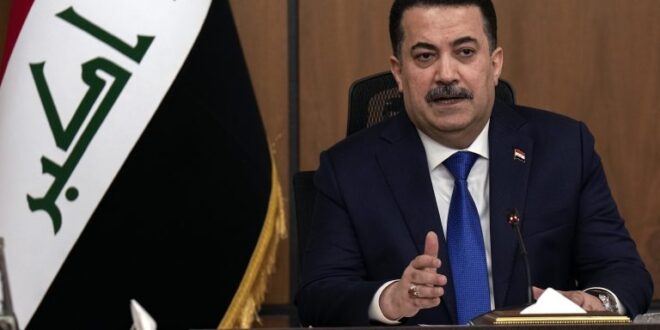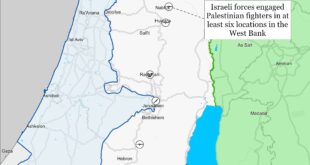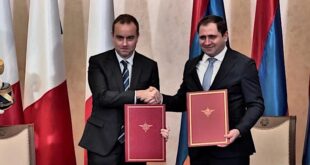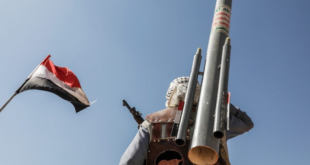- The March attack by Islamic State (IS) on a Moscow theater has dimmed the prospects for a substantial drawdown of the U.S. contingent of 2,500 military advisors and trainers still in Iraq.
- The upcoming U.S. visit of Iraqi Prime Minister Mohammed Shia al-Sudani will focus on the U.S. troop presence as well as efforts to prevent further attacks on them by Iran-backed Shia militia groups.
- Major disputes between Baghdad and Kurdish leaders in northern Iraq, as well as between major Kurdish factions, have flared over the rules for June elections in Iraqi Kurdistan.
- Many Iraqis support the stance of Iran and its allies in the ongoing Mideast crisis, but Baghdad wants to avoid alienating Washington and to limit Iran’s influence in Iraq.
As Iraqi Prime Minister Mohammed Shia al-Sudani prepares for a pivotal visit to Washington in mid-April, his government is attempting to navigate through multiple currents roiling the region, calls to distance the country from U.S. mentorship, and internal crises that continue to divide Iraq’s Arab leaders from their Kurdish counterparts that run northern Iraq. Although al-Sudani is expected to have a broad agenda for his visit, including not only security but political and economic relations, the key driver for the trip is U.S.-Iraq negotiations for a reduction in the U.S. military presence in Iraq. The U.S. military mission currently consists of about 2,500 personnel advising, mentoring, and training Iraqi forces combatting the threat posed by Islamic State (IS). In January, partly to alleviate political pressure exerted on al-Sudani by pro-Iranian Iraqi militia leaders, Iraqi and U.S. military officials announced they would hold formal talks through the bilateral U.S.-Iraq Higher Military Commission (HMC) on the mission of the U.S.-led coalition in Iraq. The announcement, which implied the U.S. would agree to reduce its presence in the country substantially, appeared to represent, in part, a U.S. effort to deprive Iran-backed groups in Iraq of a rationale to continue attacking U.S. forces. Pro-Iranian forces in Iraq and Syria attacked U.S. bases in both countries on 180 occasions from October 19 until February 3 but have since stood down following significant U.S. strikes on their facilities in early February. The U.S. agreement to consider a departure or drawdown also appeared intended to assuage an Iraqi population that is highly pro-Palestinian and has tended to support Iran’s actions against the United States and Israel since October 7.
Although it appeared that U.S. officials might acquiesce to a significant force reduction in Iraq, developments in the past two months have perhaps shifted Iraqi calculations, making a substantial U.S. drawdown less likely. The two governments are re-evaluating whether the threat to Iraq from IS has been reduced to the point where the U.S. advisory and training mission could be terminated or even significantly scaled back. The March 22 attack on a theater outside Moscow, for which IS claimed responsibility and which killed nearly 140 persons, has caused global intelligence agencies to re-evaluate the degree to which IS’ terrorism capability has been degraded. Inside Iraq, government forces announced they had killed a prominent IS fighter, Samir Khader Sharif Shihan Al-Nimrawi, on March 28, suggesting the group is showing signs of resurgence in the country. According to Iraqi authorities, Nimrawi was responsible for the transfer of fighters, weapons, and explosives between Iraq and Syria, where the group has also become more active in recent weeks against forces loyal to Syrian President Bashar Al Assad. On March 21, IS killed 11 truffle hunters in northern Syria. Nearly 900 U.S. forces remain in Syria fighting IS, while also containing the activities of Iran-backed Syrian militia operating in the east, across the border from Iraq. At a late March hearing of the House Armed Services Committee hearing, the commander of U.S. Central Command, General Michael Kurilla, testified that U.S. intelligence estimates there are around 1,000 IS fighters still fighting in Iraq. Yet, debate on the strength of IS in Iraq and Syria is unsettled: in its report on IS for the fourth quarter of 2023, the Defense Department’s Office of Inspector General said: “IS continued to conduct attacks against civilians, Iraqi and Syrian partner forces and regime forces in Syria,” but “…remained incapable of mounting large, complex attacks locally or externally, even as coalition forces increased their focus on force protection due to the Iran-aligned militia attacks.” The report characterized the militants as being in “survival posture” in Iraq and Syria, adding that, “[i]n Iraq, due to counter-terrorism pressure, the IS threat was largely contained, though IS continued to exploit security gaps between federal Iraq and the Iraqi Kurdistan Region and conducted sporadic attacks, mostly in Shia communities.”
Prime Minister al-Sudani is also likely to discuss with President Joe Biden and other U.S. officials the internal situation that is compounding the government’s challenges from IS, Iran-backed groups pushing to expel U.S. forces, Iranian efforts to influence the country, and economic difficulties. In March, a major dispute arose between federal election authorities, which run all elections within Iraqi territory, and the most powerful Iraqi Kurdish faction, the Kurdistan Democratic Party (KDP). Baghdad’s supreme court altered an election law for the long-delayed elections, planned for June 10, to vote for members of the 111-seat parliament in the Kurdish-run northern region. The court eliminated the 11 seats “reserved” for minorities (Christians, Turkomans, and Armenians) – which generally are elected in KDP-controlled territory and ensure the KDP more seats in the body than its main rival, the Patriotic Union of Kurdistan (PUK). The decision provoked the KDP to announce a boycott of the Kurdistan elections, throwing the holding of the elections into doubt outright and compounding already significant disputes between Baghdad and the Kurds over the exportation of oil from northern Iraq, revenue sharing, and other issues. U.S. officials are unlikely to try to mediate any Baghdad–Erbil disputes, but U.S. officials will likely urge al-Sudani to resolve the rift amicably. U.S. relations with Iraqi Kurdish groups have been close and extensive since the 1991 war to expel Saddam Hussein’s forces from Kuwait, and the Kurds staunchly oppose any drawdown of U.S. military forces in Iraq, some of which are based in the north to work alongside the Kurdish “peshmerga” militia units.
President Biden and other U.S. officials are furthermore certain to use the al-Sudani visit to encourage Baghdad to maintain pressure on the Iran-backed groups that remain strong and highly anti-U.S., despite standing down in the face of U.S. retaliatory attacks on their facilities. U.S. officials are confident that moderate Iraqis of all the major communities will overlook U.S. support for Israel in the Mideast crisis and oppose increased Iranian influence in Iraq. Many Iraqis view alignment with Iran as likely to alienate Iraq from the Arab world, undermine Iraqi democracy, and aid Tehran’s exploitation of Iraq’s economy. During a late March visit to Washington by Iraqi Foreign Minister Fuad Hussein, in advance of al-Sudani’s trip, U.S. Secretary of State Antony Blinken stated the U.S.-Iraq Strategic Framework Agreement (SFA) addresses not only security relations, but also many areas of economic cooperation that the al-Sudani government considers crucial, including water, energy, environment and delivery of service issues. U.S. corporations have invested extensively in these and other Iraqi economic sectors since the 2003 U.S.-led ouster of Saddam Hussein’s regime. Suggesting Baghdad did not want to jeopardize U.S. investment and other economic benefits, the Iraqi foreign minister affirmed his country remains a critical U.S. partner, and stated Baghdad needs to continue joint efforts with the United States to build Iraq’s economy. Implied, but not stated, in Hussein’s comments was Baghdad’s understanding that its relationship with Tehran, which is under extensive U.S. and other sanctions, furnishes little, if any, tangible economic benefit to the Iraqi people. Baghdad is unlikely to distance itself from the United States because of ideological and political pressure from Iran, Iran’s allies in Iraq, or even from the sentiment of the population that is highly critical of the U.S. stance on the Israel-Hamas war. Still, it remains an open question whether Iraq would be willing, or able, to act against Iran-backed militias if the groups resume their attacks on U.S. bases in the country. With yesterday’s Israeli strike on a high-ranking Islamic Revolutionary Guard Corps – Quds Force (IRGC-QF) compound in Damascus, Syria, three IRGC-QF generals were reportedly killed. The Damascus strike will almost certainly be met with an escalatory response from Iran and its so-called “Axis of Resistance,” which could come in the form of a Hezbollah strike against Israel, more Houthi missile and drone attacks in the Red Sea, militias in Syria firing at U.S. troops, or perhaps something more direct from the IRGC-QF itself.
 Eurasia Press & News
Eurasia Press & News




